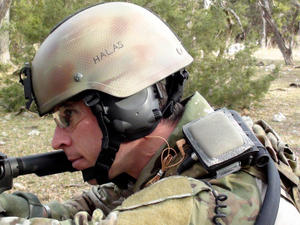In the trenchesAcoustic gunfire detection devices heading to the field
Technological developments may one day create artificial soldiers, but until they come along, the United States and other countries will continue to rely on human soldiers; the militaries thus want to preserve as many of their soldier’s lives as possible; to that end, Shoulder-Worn Acoustic Targeting System (SWATS), which helps Marines zero in on enemy sniper fire, is a godsend to the United States; asymmetric warfare favors the forces that can strike and runaway unharmed, but with plentiful acoustic sensors in the field it will be that much harder for snipers to ambush U.S. soldiers and live to escape

The SWATS in operational position // Source: marinecorpstimes.com
The Marine Corps is ordering several hundred gunfire detection devices for use in Afghanistan, at pre-deployment training sites, and at bases throughout the Corps.
Called the Shoulder-Worn Acoustic Targeting System, or SWATS, the Corps already has sent more than 150 of the devices to Afghanistan in an effort to help Marines zero in on the origin of sniper fire.
The Marine Corps Times reports that the first set of SWATS arrived in Afghanistan in late spring and early summer and quickly proved successful in combat, according to a branch head at the Marine Corps Combat Development Command in Quantico, Virginia.
Five hundred additional units were ordered in January for use in theatre and elsewhere, said Patrick R. Cantwell, the head of Combat Development and Integration’s Maneuver Branch.
Produced by Virginia-based QinetiQ North America, SWATS works by detecting the whiz of a bullet in flight and the muzzle blast to provide the approximate bearing and distance of an enemy shooter’s position.
“What it provides the war fighter, any time they are in harm’s way, is real-time situational awareness that they would otherwise not have,” said Andrew Rogers, vice president of QinetiQ’s survivability division. “Just having that knowledge allows he or she to take appropriate action, which could save their life or their fellow soldier’s or Marine’s life.”
The device consists of a small sensor box worn on the shoulder, connected by wire to an earpiece and a small visual display, about the size of a wallet, that is strapped to the chest. When a shot is taken at troops, the device provides them with an audio warning and a read-out with range and compass bearing.
Downrange, the device will continue to be field-tested, to further refine the system and decide how it is used in the future, said Patrick R. Cantwell, the head of Combat Development and Integration’s Maneuver Branch.
SWATS’ effective range depends on the environment, Rogers said. In urban terrain, the sound of a muzzle blast echoes off buildings and vehicles. That makes calculating range challenging. But, through programming and audio filters, the device still is effective out to several hundred meters.
Afghanistan’s rural, open terrain is an ideal environment for the device, where it can zero in on snipers at greater distances, Rogers said.
